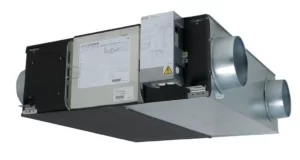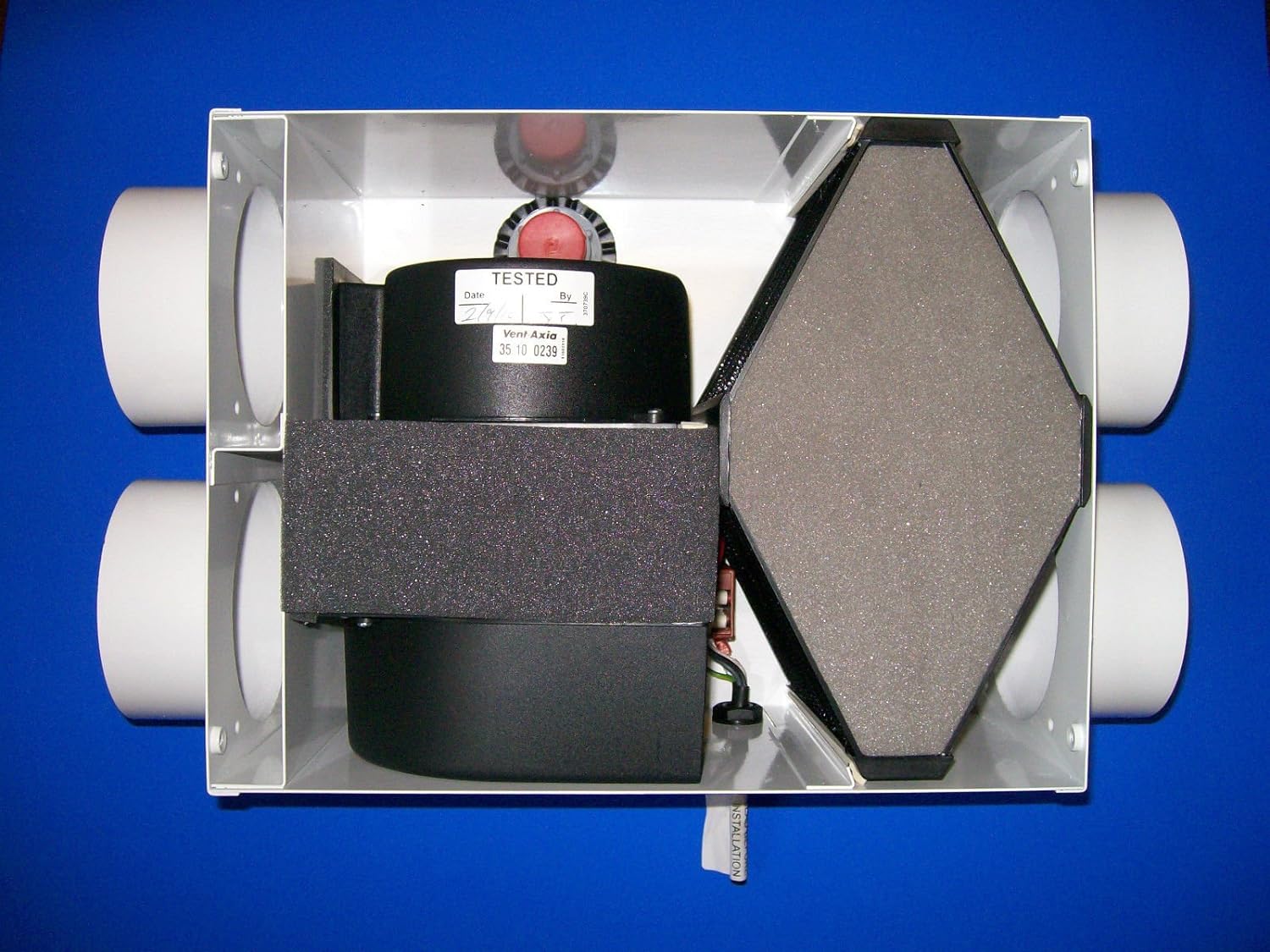Are you tired of constantly adjusting your thermostat to stay comfortable in your home or office? Do you wish there was a more efficient way to control the temperature? Look no further than a Heat-Exchange Ventilation Fan. This innovative and cost-effective solution can provide efficient climate control by exchanging heat between the indoor and outdoor air. In this blog post, we will explore the benefits of Heat Exchange Ventilation Fan and how they can keep you comfortable all year round. Say goodbye to high energy bills and hello to a more sustainable and comfortable environment.
Understanding the Basics of Heat-Exchange Ventilation Fans
Heat-exchange ventilation fans are a key component in creating an efficient and comfortable indoor climate. Understanding the basics of how these fans work can help you make an informed decision about whether they are the right choice for your home or office.
At their core, heat-exchange ventilation fans operate by extracting stale indoor air and replacing it with fresh outdoor air. But what sets them apart is their ability to transfer heat between the outgoing and incoming air streams. In the winter, the fan will extract warm air from the inside and transfer it to the incoming cold air, effectively warming it up before it enters your space. In the summer, the fan will remove the hot air from your space and transfer it to the cooler incoming air, helping to cool down your indoor environment.
By effectively exchanging heat, these fans provide a consistent and comfortable temperature throughout your home or office without the need for constant thermostat adjustments. It not only enhances your comfort but also helps to reduce your energy consumption and lower your utility bills.
In addition to climate control, heat-exchange ventilation fans also contribute to improved indoor air quality. By constantly exchanging the air, they remove pollutants, allergens, and odours, ensuring a healthier living or working environment. It can be particularly beneficial for individuals with respiratory issues or allergies.
How Does Heat Exchanger Fan Enhance Climate Control Efficiency?
Heat-Exchange Ventilation Fans are a game-changer when it comes to climate control efficiency. These innovative fans not only provide a constant and comfortable indoor temperature but also help to reduce energy consumption, making them an excellent choice for homeowners and businesses alike.
The key to the climate control efficiency of Heat Exchanger Fan lies in their ability to transfer heat between the outgoing and incoming air streams. In the winter, the fan extracts warm air from the inside and transfers it to the incoming cold air, effectively warming it up before it enters your space. It means that you can enjoy a cozy and warm environment without cranking up the thermostat.
In the summer, the fan removes the hot air from your space and transfers it to the cooler incoming air, helping to cool down your indoor environment. It eliminates the need for expensive air conditioning units, reducing your energy consumption and lowering your utility bills.
By efficiently exchanging heat, Heat-Exchange Ventilation Fans ensure a consistent temperature throughout your home or office, eliminating the need for constant thermostat adjustments. It not only enhances your comfort but also contributes to a more sustainable and eco-friendly lifestyle.
With the help of Heat-Exchange Ventilation Fans, you can enjoy efficient climate control while reducing your energy consumption and saving money on your utility bills. It’s a win-win situation for both your comfort and your wallet.
The Home Ventilator Cost is Affordable
When it comes to enhancing the climate control of your home or office, cost is always a factor to consider. Thankfully, Heat-Exchange Ventilation Fans provide an affordable solution that won’t break the bank. Not only are these fans energy-efficient and environmentally friendly, but they also offer a cost-effective way to maintain a comfortable indoor environment.
Compared to other climate control options, such as air conditioning or heating systems, Home Ventilator Cost are much more affordable to purchase and install. Their simple design and ease of installation mean that you won’t have to spend a fortune on professional installation or complex ductwork.
Furthermore, the energy savings that come with using Heat-Exchange Ventilation Fans can also save you money in the long run. By efficiently exchanging heat between the indoor and outdoor air, these fans reduce the need for constant thermostat adjustments and decrease your reliance on heating or cooling systems. It leads to lower energy consumption and reduced utility bills.
 Key Benefits and Applications of Air Ventilation Unit
Key Benefits and Applications of Air Ventilation Unit
When it comes to air-ventilation units, several key benefits and applications make them a valuable addition to any space. Firstly, air-ventilation units improve indoor air quality by constantly exchanging stale indoor air with fresh outdoor air. It helps to remove pollutants, allergens, and odours, creating a healthier living or working environment.
Another major benefit of air-ventilation units is their ability to regulate temperature and humidity levels. By extracting excess moisture from the air, these units can help prevent mould and mildew growth, reducing the risk of respiratory issues and property damage.
Additionally, Air Ventilation Unit are highly versatile and can be used in a variety of settings. They are commonly used in residential homes, offices, schools, hospitals, and industrial facilities. Whether you need to improve the air quality in your bedroom, maintain a comfortable work environment, or ensure the safety of workers in a factory, air-ventilation units are a reliable solution.
Selecting the Right Industrial Ventilation for Your Needs
Selecting the right Industrial Ventilation system for your needs is crucial in creating a safe and comfortable working environment. With so many options available, it can be overwhelming to determine which system is best suited for your specific requirements. However, by considering a few key factors, you can make an informed decision that ensures optimal performance and efficiency.
Firstly, assess the size and layout of your industrial space. Determine the airflow requirements, taking into account factors such as the number of occupants, equipment, and processes that generate heat or pollutants. It will help you choose a ventilation system that can effectively circulate and purify the air in your facility.
Next, consider the specific needs of your industry. Different industries have different ventilation requirements. For example, suppose you work in a manufacturing facility that deals with hazardous chemicals. In that case, you may need a ventilation system with specialized filters and exhaust mechanisms to maintain air quality and remove toxic fumes.
It’s also important to consider energy efficiency. Look for ventilation systems that are designed to minimize energy consumption while still providing adequate air exchange. Energy-efficient systems can help you reduce your carbon footprint and lower your utility costs.
Additionally, consider the noise levels of the ventilation system. Industrial environments can already be noisy, so it’s essential to choose a system that operates quietly to avoid adding unnecessary noise pollution.
Tips on Maintaining Your Ventilation Installation
Proper maintenance is crucial to ensure the longevity and efficiency of your Ventilation Installation. Here are some helpful tips to keep your ventilation system running smoothly:
- Regular Cleaning: Regularly clean the vents, filters, and ducts to prevent the buildup of dust, debris, and pollutants. It will ensure optimal airflow and improve air quality.
- Check for Leaks: Inspect the ductwork for any leaks or gaps that could affect the performance of your ventilation system. Seal any leaks promptly to maintain efficiency.
- Replace Filters: Replace air filters regularly, as clogged or dirty filters can restrict airflow and decrease the effectiveness of your ventilation system. Check the manufacturer’s recommendations for filter replacement intervals.
- Monitor Humidity Levels: High humidity can lead to mould and mildew growth, which can impact indoor air quality. Use a hygrometer to monitor humidity levels and take necessary steps to control moisture, such as using dehumidifiers or improving ventilation in areas prone to moisture buildup.
- Schedule Professional Maintenance: Periodically, have a professional technician inspect and service your ventilation system. They can identify any issues, perform necessary repairs or adjustments, and ensure that your system is functioning optimally.
Maximizing Comfort and Energy Efficiency with Exhaust Ventilation System
When it comes to maximizing comfort and energy efficiency, an exhaust-ventilation system is a game-changer. This innovative system not only helps to maintain a comfortable indoor environment but also significantly reduces energy consumption, making it an excellent choice for homeowners and businesses.
One of the key benefits of an Exhaust Ventilation System is its ability to remove stale air and odours from your space, ensuring fresh and clean indoor air quality. By continuously extracting indoor air and replacing it with fresh outdoor air, these systems help to create a healthier and more comfortable living or working environment.
In addition to improving air quality, exhaust-ventilation systems also play a vital role in energy efficiency. By expelling excess heat, humidity, and pollutants from your space, these systems reduce the workload on your heating, ventilation, and air conditioning (HVAC) system. This results in lower energy consumption, decreased utility bills, and a more sustainable lifestyle.
FAQs
1. Are Heat-Exchange Ventilation Fans noisy?
No, Heat-Exchange Ventilation Fans are designed to operate quietly, ensuring that they don’t add unnecessary noise pollution to your space. You can enjoy the benefits of a comfortable indoor environment without any annoying buzzing or humming sounds.
2. Can Heat Exchange Ventilation Fans be installed in any space?
Yes, Heat-Exchange Ventilation Fans are highly versatile and can be installed in a variety of settings, including residential homes, offices, schools, hospitals, and industrial facilities. Whether you need to improve air quality in your bedroom or maintain a comfortable work environment, these fans are a reliable solution.
3. Do Heat-Exchange Ventilation Fans require professional installation?
While it’s always recommended to consult with a professional for installation, Heat-Exchange Ventilation Fans are generally easy to install and don’t require complex ductwork. With a bit of DIY knowledge, you can install them yourself and start enjoying the benefits of efficient climate control.
4. Can Heat-Exchange Ventilation Fans help reduce allergies?
Yes, Heat-Exchange Ventilation Fans can help improve indoor air quality by constantly exchanging the air and removing pollutants, allergens, and odours. It can be particularly beneficial for individuals with respiratory issues or allergies, providing them with a healthier and more comfortable living or working environment.
Conclusion
A Heat-Exchange Ventilation Fan is a game-changer when it comes to efficient climate control. Not only does it provide a constant and comfortable indoor temperature, but it also reduces energy consumption and lowers utility bills. With the ability to exchange heat between indoor and outdoor air, these fans create a more sustainable and eco-friendly environment. Additionally, they improve indoor air quality by removing pollutants and allergens. Say goodbye to constant thermostat adjustments and hello to a more comfortable and cost-effective solution. Upgrade your home or office with a Heat-Exchange Ventilation Fan today!



